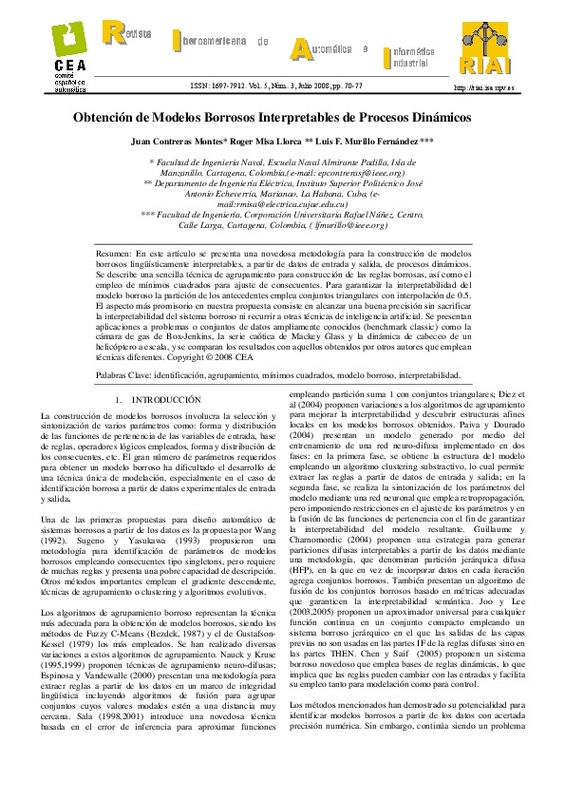JavaScript is disabled for your browser. Some features of this site may not work without it.
Buscar en RiuNet
Listar
Mi cuenta
Estadísticas
Ayuda RiuNet
Admin. UPV
Obtención de Modelos Borrosos Interpretables de Procesos Dinámicos
Mostrar el registro sencillo del ítem
Ficheros en el ítem
| dc.contributor.author | Contreras Montes, Juan
|
es_ES |
| dc.contributor.author | Misa Llorca, Roger
|
es_ES |
| dc.contributor.author | Murillo Fernández, Luis F.
|
es_ES |
| dc.date.accessioned | 2020-06-05T14:50:58Z | |
| dc.date.available | 2020-06-05T14:50:58Z | |
| dc.date.issued | 2008-07-09 | |
| dc.identifier.issn | 1697-7912 | |
| dc.identifier.uri | http://hdl.handle.net/10251/145496 | |
| dc.description.abstract | [EN] A novel methodology for constructing linguistically interpretable fuzzy models, from input and output data, of dynamics processes is presented. An easy clustering technique for constructing fuzzy rules and the application of least square means for adjusting consequent parameters is described. For the antecedent of each fuzzy rule, triangular membership function with overlap of 0.5 is used to guarantee the interpretability of the fuzzy model. The most promising aspect in our approach is the trade-off between a high accuracy and high interpretability. Furthermore, the use of another technique of artificial intelligence is not needed. Applications to a well known data sets Applications to a well known data sets are presented: Box-Jenkins gas furnace, Mackey-Glass chaotic series and vertical motions of a scaled down of a helicopter. The results are weighed against those achieved by another methods. | es_ES |
| dc.description.abstract | [ES] En este artículo se presenta una novedosa metodología para la construcción de modelos borrosos lingüísticamente interpretables, a partir de datos de entrada y salida, de procesos dinámicos. Se describe una sencilla técnica de agrupamiento para construcción de las reglas borrosas, así como el empleo de mínimos cuadrados para ajuste de consecuentes. Para garantizar la interpretabilidad del modelo borroso la partición de los antecedentes emplea conjuntos triangulares con interpolación de 0.5. El aspecto más promisorio en nuestra propuesta consiste en alcanzar una buena precisión sin sacrificar la interpretabilidad del sistema borroso ni recurrir a otras técnicas de inteligencia artificial. Se presentan aplicaciones a problemas o conjuntos de datos ampliamente conocidos (benchmark classic) como la cámara de gas de Box-Jenkins, la serie caótica de Mackey Glass y la dinámica de cabeceo de un helicóptero a escala, y se comparan los resultados con aquellos obtenidos por otros autores que emplean técnicas diferentes. | es_ES |
| dc.language | Español | es_ES |
| dc.publisher | Universitat Politècnica de València | es_ES |
| dc.relation.ispartof | Revista Iberoamericana de Automática e Informática industrial | es_ES |
| dc.rights | Reconocimiento - No comercial - Sin obra derivada (by-nc-nd) | es_ES |
| dc.subject | Identification | es_ES |
| dc.subject | Clustering | es_ES |
| dc.subject | Least mean square | es_ES |
| dc.subject | Fuzzy model | es_ES |
| dc.subject | Interpretability | es_ES |
| dc.subject | Identificación | es_ES |
| dc.subject | Agrupamiento | es_ES |
| dc.subject | Mínimos cuadrados | es_ES |
| dc.subject | Modelo borroso | es_ES |
| dc.subject | Interpretabilidad | es_ES |
| dc.title | Obtención de Modelos Borrosos Interpretables de Procesos Dinámicos | es_ES |
| dc.title.alternative | Obtaining Interpretable Fuzzy Models of Dynamics Processes | es_ES |
| dc.type | Artículo | es_ES |
| dc.rights.accessRights | Abierto | es_ES |
| dc.description.bibliographicCitation | Contreras Montes, J.; Misa Llorca, R.; Murillo Fernández, LF. (2008). Obtención de Modelos Borrosos Interpretables de Procesos Dinámicos. Revista Iberoamericana de Automática e Informática industrial. 5(3):70-77. http://hdl.handle.net/10251/145496 | es_ES |
| dc.description.accrualMethod | OJS | es_ES |
| dc.relation.publisherversion | https://polipapers.upv.es/index.php/RIAI/article/view/8297 | es_ES |
| dc.description.upvformatpinicio | 70 | es_ES |
| dc.description.upvformatpfin | 77 | es_ES |
| dc.type.version | info:eu-repo/semantics/publishedVersion | es_ES |
| dc.description.volume | 5 | es_ES |
| dc.description.issue | 3 | es_ES |
| dc.identifier.eissn | 1697-7920 | |
| dc.relation.pasarela | OJS\8297 | es_ES |






